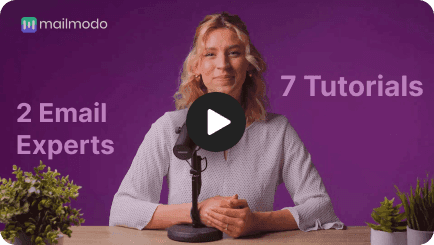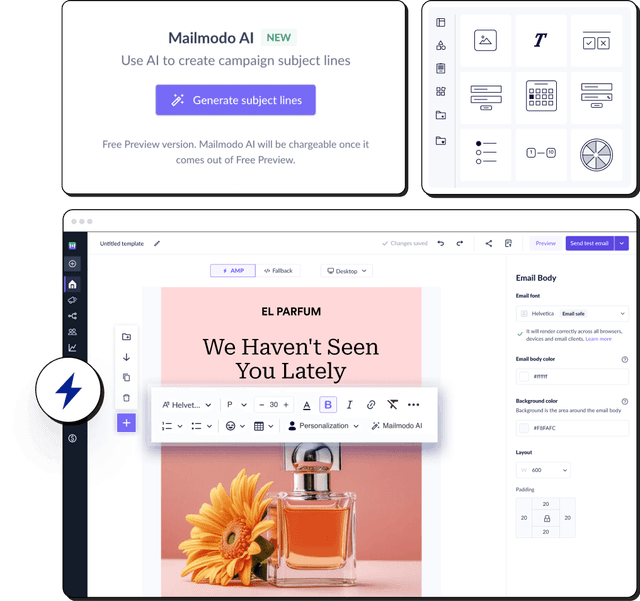What is a drip campaign?
A drip campaign is an automated email marketing strategy that sends a sequence of pre-written emails to people who take a specific action on a website, web app, or application.
It allows businesses to build relationships with leads by providing valuable and relevant content over time, guiding them through the buyer's journey. This approach establishes businesses as authorities in their niche and positions them as valuable resources for their audience's needs.
A drip campaign is also known as an automated email campaign, drip marketing campaign, drip email sequence, or nurture campaign. It is also called behavioral email because it is triggered in response to the user's behavior and actions.
For example, suppose a new subscriber registers on the company's website. In that case, send a welcome email followed by an educational email post for 1 or 2 days.
What are the benefits of drip email campaigns?
A successful drip campaign targets the right audience with the right information at the right time. As per Litmus State of Email Report 2021, 67% of marketers focus on a drip campaign strategy to increase sales.
Let's look at some other benefits you can get via drip email marketing:

1. Keep customers engaged
A single email won't suffice, as users go through many steps before they become customers. So, drip sequences can help you boost engagement.
You can create a series of emails to nurture new customers and move them to the next stage. Be it a welcome email series or re-engagement flow, these drips will help you convert leads into prospects and humanize the entire conversion process.
2. Save time and effort
As each email is pre-written and designed, writing individual emails every time a user takes action can be tiresome. By setting up automated sequences, you can cut that time and focus on more important tasks.
3. Nurture customer relationships
You cannot survive in a competitive environment without a strong customer base. That's why you need to build a stronger relationship with your customers. With the series of emails, you can cater to your customer's needs through the right content.
To build such a relationship, you must engage with them and offer them value through each email. Drip marketing is a great way to do that. You can create a humanized experience through well-curated personalized emails through a series of different emails.
4. Re-engage inactive readers
People can become inactive due to many reasons, and you'll never know if you don't keep a check on it. Drip campaigns help you do that.
By setting a re-engagement drip sequence, you can reach out to them and ignite their interest once again. Be it a cart recovery, win-back, or browse abandonment, there might be an opportunity to ignite the engagement.
5. Increase customer retention & reduce churn
You can use the right drip campaign to retain and turn customers into loyal ones. You can set up the upselling and cross-selling flow by analyzing users' behavior to boost retention. The more you can retain your customers, the lower the churn rate and the acquisition cost.
Targeting audience segments with the right email at the best time gives them a reason to stick around if that content resonates with them.
8 use cases of a drip campaign marketing
To keep users engaged with the brand's offerings, marketers can use drip campaigns in different ways. There are various types of drip campaigns you can follow
1. Lead nurturing drip campaign email sequence
Leads are the lifeline for B2B brands. These people might not be well acquainted with your product and services, where the lead nurturing sequence comes in.
As new leads aren't ready to buy, that doesn't mean they never will. You can nurture them, build trust, and nudge them towards conversions through engaging and the right emails. Many other email series, such as - welcome, onboarding, and follow-up, align with the lead nurturing sequence.
To help you out, here's a lead nurturing drip campaign example for SaaS brands. Check out our lead nurturing email flow to understand this sequence and get expert insights.

2. Welcome drip campaign email sequence
Welcome emails are the best way to stand out and appreciate readers for joining your brand. These emails are great for showing what your company and product are all about, but they also help you build a strong foundation with your existing and potential customer base.
A planned welcome email series will build trust and keep the conversation going with the new readers.
Given below is a good example of a welcome drip campaign. It welcomes users, gets them onboarded, and shares useful resources to inform readers about the brand and the industry. Get the detailed breakdown of this welcome drip email series for SaaS.
The beauty of drip campaigns is in timing and personalized messaging. One of my B2B clients had a 278% increase in qualified leads after we deployed a welcome sequence of targeted content by industry and role. Their sales cycle dropped from 45 days to 28 days.
— Sheraz Ali, Founder of HARO Agency

3. Onboarding drip campaign email sequence
The main goal of B2B SaaS brands is to convert leads or freemium users into paid ones. Onboarding email drips are the key to converting them. These emails show how different features work and what users will get from them.
You take users through a step-by-step journey, be it an account setup, a new feature, or showing the benefits of premium versions. With onboarding emails, you take users through what they're currently getting and what more they can get via the paid version.
One of the emails in this onboarding sequence is case studies, as social proof is among the strongest decision drivers. And it should be a part of your onboarding emails as it enforces credibility. Get the detailed version of this self-serving onboarding drip sequence.

4. Abandoned cart drip campaign email sequence
According to Baymard Institute, eCommerce's average cart abandonment rate stands at 69.8%, meaning 3 out of 4 people leave without completing the transaction.
That's a huge loss in sales. But, an abandoned cart drip series can help recover the loss. The Klaviyo eCommerce benchmark 2022 report states that these email series have an open rate of 50%, generating a conversion of 3.72%. It amounts to the revenue of $3.42 revenue per recipient (RPR) - the highest among all email campaign flow.
So, abandoned shopping cart emails are your chance to recover sales. The typical email flow for cart recovery consists of 2-3 emails with a reminder and discount offer email. Check out how to create an abandoned cart drip campaign flow that converts.

💡 Related guide: How to Create Abandoned Cart Emails to Recover Lost Sales
5. Event registration drip campaign email series
Events have become omnipresent in the past two years, and their rising trend is self-evident. Webinars and seminars are gaining traction as they help build brand awareness and generate leads.
But, to get more registration, event registration drip series are a must. The flow begins a few weeks before the event with registration confirmation emails followed by reminder emails.
This event registration drip sequence is one of the typical flows you can set up. Read more about it and learn what experts have to say.

6. Win-back/re-engagement drip campaign series
People change their email addresses, lose interest in your email content, shift jobs, and whatnot. It's basic human nature. But that doesn't mean you shouldn't try to win them back.
Win back, or re-engagement drip emails are sent to inactive or disengaged users in your email list. The duration to track the inactivity can vary from the last 30 days or 60 days, depending upon your business strategy and goals.
By analyzing these users' behavior and activity across your website and email, you can identify which kind of email will be best suited for them. Once you decide that, you can start assembling the sequence, which can look like this. Read about the win-back email sequence in detail.

7. Free trial email drip campaign series
One of the tasks of every SaaS brand is to convert free trial users to paid users. This free trial drip sequence aims to do that.
This email series is often longer than others, requiring users to get familiar with the free features and nudging them towards the premium versions. Case study emails, feedback, and follow-up emails are some of the emails used in this sequence.

8. Feedback email drip campaign series
Customer feedback is imperative, no matter which industry you work in. It helps build trust and gain insights into what's working and not.
Feedback emails need a pre-planned series as often the readers might not reply to you. A strategically planned email series resolves that issue by offering the right incentive to compel them to complete the survey or form.
In this feedback drip campaign example, a second email gives them an incentive to fill out the form, followed by an acknowledgment email once they complete it.
💡 Related guide: Feedback Email Guide: Use cases, Benefits, and Examples
How to set up a drip campaign
Setting up the right drip campaign flow can be overwhelming. There are many factors to consider, including:
Types of triggers
Ease of audience segmentation
Type of drip sequence builder.
Pricing
Personalization availability, etc.
That's where drip campaign software can help you. Most ESPs offer in-build automation features to create effective drips and send them to your customers. Mailmodo is among such ESPs.
This section will discuss different steps to build a drip sequence and how Mailmodo's drip sequence builder can help you at each step.
The first step is reverse-engineering the customer journey—where do people drop off, and what information would help them move forward? From there, create a sequence with logical progression rather than random emails.
- Ani Ghazaryan, Head of Content at neptune.ai
But before we move further, get familiar with the following terms, as they will come in handy:
Trigger: It defines when you want to trigger a journey. For example, you can set the trigger to 'when a contact is added to the email list.'
Action: Action refers to activities you do to create the automated journey. Everything is counted as an action, from adding a new campaign to integrating with webhooks.
Delay: Delay refers to the waiting period between two emails. You can add two types of delays: wait for some time or wait until a period.
Conditions: These refer to conditions you put on each email to define what should be triggered next in the journey. You can add these conditions: opened, clicked, or submitted.
Now that you are familiar with the basic terminology, let's discuss steps to set up your email marketing drip campaign flow:
1. Identify and segment your audience
A welcome email sequence won't appeal to everyone as it aims to fulfill a specific task - to nurture those who signed up for the first time. Adding existing customers to this series is nothing but asking for trouble.
That's why identifying the right audience is crucial.
Once you identify whom you want to serve, consider the traits you can use to group them.
Do they belong to the same age group?
Did they sign up for the same type of email?
Do they share the same values and pain points?
How long ago did they sign up?
When was the last time they opened and clicked on your emails?
What makes them different from everyone else and similar to each other?
-Seth Godin
Answer this question, and you'll get the right segment to target. This step is crucial as every trigger and condition you set up will be tied back to your audience.
2. Create emails
Once you identify the target audience, you can start creating and designing the email. At this step, you must estimate how many emails there will be in the sequence.
Here are a few things you must consider when creating emails for the drip series:
Use the subject line and preheader text to hook the reader.
Make your email copy enticing, attention-grabbing, and conversational.
Maintain your brand voice and tone throughout all the emails.
Add images and GIFs to present information in a digestible manner.
Make your email more inviting by adding white space.
Don't forget to use high color contrast, legible font size, and alignment for accessibility purposes.
In Mailmodo, as soon as you choose the trigger, you are asked to choose the template. You can choose a new template or choose from a library of pre-made HTML and AMP email templates. We aim to make it as easy and efficient as possible to create drip email campaigns for you.
3. Set up the drip campaign
At this step, visualize the email drip sequence by answering the following questions:
What are the different triggers you'll use?
How many emails will there be in the sequence?
What will be the time interval between each?
What are the different conditions you'll use to send the email?
How many emails will you send until you break up with the prospect?
What will you do even after the sequence user is not converted?
In Mailmodo's journey builder, you can add or remove email sequences as you like. Furthermore, add conditions (opened, clicked, and submitted) and delays between the emails to send more relevant emails.
4. Review and make the drip campaign live
Once you finish the drip campaign sequence, check all the triggers, contact lists, and conditions are set in place. After reviewing, you can save the journey as a draft or instantly activate it.
You've put a lot of effort into creating the drip campaign, don't leave it hanging once it's live. Keep track of how each email performs by tracking the right email metrics such as click rate, conversion rate, etc.
Monitoring will give you insights into what's working and where you can optimize for better performance.
Getting low conversions? Try changing the CTA positioning, copy, or design.
Not setting open enough? Try tweaking the subject line.
Here's an overview of what Mailmodo's drip sequence analytics dashboard looks like:
You can see the metrics in one glance by customizing the period.
Contact overview: You can see the total contacts, contacts still on the journey, and contacts who have completed/failed the journey.
Activity log: A tabular or graphical representation of your campaign's performance.
Journey summary: See all the metrics for each email in the journey
Enroll: Add existing or new contacts.
Pause to edit the journey: This feature is helpful as you can test the journey if you find anything not working out.
Three dots: To test, preview, or change the name of the journey.
Check out what each metric means and how you can use it to draw analysis.

Drip campaign email marketing best practices
Drip campaign marketing will only be fruitful if you follow the right practices. So, we have enlisted some of the best practices you should follow to do drip campaign marketing the right way:

1. Set the right timing and frequency via A/B testing
The success of drip sequences depends on the timings and frequency of different emails. No one will check your email if you bombard them with an array of emails and send them emails during their off hours.
You can assume the timings that'll work, or you can A/B test different timing and frequency. A/B testing the timings will give you data backed up by the users' behavior, based on which you can make your analysis.
2. Be personal in your emails
Even though your emails are automated, that doesn't mean you should sound robotic. Make your email personal, as no one likes to speak to robots. The humanized conversation is your key to building stronger relationships.

So, ensure you have an email address that shows your or your company's name. Make emails personalized using recipients' or company names, work experience, etc.
Keep emails short and actionable—no one wants to read a wall of text. Personalization is key, so use the recipient’s name and tailor content based on their behavior. Always space out emails to avoid overwhelming people.
— Ilya Telegin, Head of Content at improvado
3. Study the users' behavior before you set up the trigger
The trigger you set up should be relevant to user preferences and behavior. Everyone isn't interested in your product, so sending an email blast won't yield any benefit. So, once you segment your email list, analyze the users' behavior.
See how they interact with your emails, which emails they spend and click on, and whether they click on the CTA. All this data will help you better understand your users and create many more target sequences with high chances of conversion.
4. Track users' behavior apart from emails
Every email you send often redirects to your website or another platform. That's why you should avoid limiting your analysis to emails alone. See which page they interact on your website, which lead magnets they download and do they engage with your posts on social media.
The cross-channel analysis will offer you more insights through which you can create more targeted sequences.
5. Add a ‘manage preferences’ link
If you have different email types, frequencies, and timings, try adding a 'manage preference' link in your emails. It offers recipients options to customize the email they would like to receive. It'll also help you understand their preference, based on which you can personalize the emails in the sequence.
Furthermore, as each email gets relevant to them, you'll see less unsubscribing and more engagement.
Way forward
Getting the right drip email sequence is a bit tricky. There are loads of variables to consider - timing, frequency, type of email, the delay between each email, etc.
Our team understood this pain and came up with the brilliant idea of creating a hub of email sequences for different industries and use cases. This resource was created to help you get ideas for your next drip campaign, save time, and get a higher ROI. So, check out our library of email flows and engage your subscribers.




















